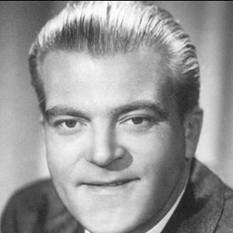
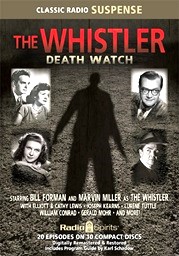 “I am the Whistler, and I know many things, for I walk by night. I know many strange tales, many secrets hidden in the hearts of men and women who have stepped into the shadows. Yes… I know the nameless terrors of which they dare not speak.”
“I am the Whistler, and I know many things, for I walk by night. I know many strange tales, many secrets hidden in the hearts of men and women who have stepped into the shadows. Yes… I know the nameless terrors of which they dare not speak.”
The Whistler (1942-55) aired “What Makes a Murderer”” on August 13, 1945 as the 168th of its 760+ episodes (depending on how one counts). It is the 11th episode of the show we have run since 2017 and only the third since December of 2021. For newcomers, introductory background material on the show is reprised below (it was the most popular west coast radio show for many years), with the background providing context for its not totally unique but unusual narrative format.
There were two attempts for The Whistler to break into the east coast market that didn’t last long (July-September 1946, and March 1947-September 1948) due to mediocre ratings, so if these episodes are counted as part of the overall scheme of things, the total number of shows ends up somewhere around 769. Over its thirteen-year west coast run it never took a summer break and ran continuously, certainly some kind of record, and its sole west coast sponsor, Signal Gas & Oil remained loyal throughout. While the show had several narrators over the years, the one who held the longest tenure and is most associated with the show was Bill Forman (1915-1966, photo top right). Though Forman is the most recognized narrator for his work in 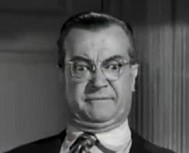
 most of its later years, two of the show’s earlier narrators would also become recognizable for both their radio work and television personalities, Joseph Kearns (1907-62, photo at left) being one and Gale Gordon (1906-95, photo at right) being the other. Kearns (as did Gordon) had a long radio career, and would win notoriety for his ability to mimic almost any voice. Combining his amazing vocal talent along with his acting chops, Kearns would find work in hundreds of episodes of radio shows prior to any TV work that came his way. The TV role he was most associated with was of course Dennis the Menace (1959-63), where he played Dennis’s grumpy old neighbor George Wilson. When Kearns died in February of 1962 he was replaced by none other than his long time radio pal Gale Gordon until the show left the air. Another bit of trivia is that Kearns also wrote at least one script for the show, showing once again that he was not only a capable actor with a rare voice talent but a writer as well.
most of its later years, two of the show’s earlier narrators would also become recognizable for both their radio work and television personalities, Joseph Kearns (1907-62, photo at left) being one and Gale Gordon (1906-95, photo at right) being the other. Kearns (as did Gordon) had a long radio career, and would win notoriety for his ability to mimic almost any voice. Combining his amazing vocal talent along with his acting chops, Kearns would find work in hundreds of episodes of radio shows prior to any TV work that came his way. The TV role he was most associated with was of course Dennis the Menace (1959-63), where he played Dennis’s grumpy old neighbor George Wilson. When Kearns died in February of 1962 he was replaced by none other than his long time radio pal Gale Gordon until the show left the air. Another bit of trivia is that Kearns also wrote at least one script for the show, showing once again that he was not only a capable actor with a rare voice talent but a writer as well.
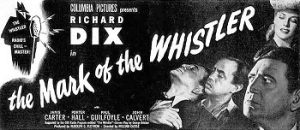
The Whistler has an interesting backstory, and would take much too long to go into here to give it the justice it warrants. A few points of interest will suffice for this offering of the beloved mystery show, the first of which is the use of the narrator as more than just a host. From Jim Ramsburg’s Gold Time Radio entry on The Whistler: “Like The Shadow’s first personification a dozen years earlier, Inner Sanctum’s ghostly Raymond in 1941 and The Mysterious Traveler in 1943, The Whistler stood outside the stories he narrated. Unlike the others, he used a unique second-person, present tense technique as if to talk directly with the central character of his stories – often an innocent drawn into the plot by circumstances or an amateur driven to murder as a last resort.” A second point of interest has to do with the trademark whistling that opens each episode. From Radio Spirits‘ Blog Archive on The Whistler: “The program featured one of radio’s classic openings: a haunting 13-note theme created by Wilbur Hatch (who also composed the show’s eerie mood music). Hatch estimated that only one person in twenty could whistle this exact melody, and for the show’s thirteen-year duration one person pretty much did—a young woman named Dorothy Roberts. In fact, during the war years, Roberts had to get permission from Lockheed (where she worked) to leave her factory job in order to make it to the program and whistle every week.”
The radio show proved popular enough that Columbia Pictures made eight Whistler films from 1944-48, all but one starring Richard Dix: The Whistler (1944), The Mark of the Whistler (1944), The Power of the Whistler (1945), The Voice of the Whistler (1945), Mysterious Intruder (1946), The Secret of the Whistler (1946), The Thirteenth Hour (1947) and The Return of the Whistler (1948). The show was brought to early television in 1954-55, but never caught on. Nevertheless (and due in great measure to roughly 500 of the estimated 700+ original shows still surviving–-and the movies still showing up on classic movie TV channels), The Whistler probably enjoys a larger audience today than it did in its heyday during the Golden Age of Radio.
“What Makes a Murderer” is interesting for several reasons. Firstly, notable immediately is the setup, the idea driving the story. Two fellow workers and friends voice their observations that boredom rules their lives. They spend their every waking moment slaves to routine which leads to a case of extreme ennui. They kiss their wives goodbye every morning, then catch the same train to their job at the same time every day. Their mindless desk jobs never vary from day to day. They then take the same train at the same time on their way home to their wives every evening. Their routine of eating dinner at the same time every day never varies. They read the daily paper after dinner and then go to bed at the same time every night. Rinse and repeat for years. Until, that is, one of the friends decides to break the pattern by taking a small but important break in the unbroken timestream of his life. This change involves an impulsive risk, the risk of betting a few dollars at the track…and winning big! His winnings now offer a measure of freedom he has not enjoyed for many years. Throwing caution to the wind he leaves his old life behind and heads for Florida and the promise of excitement he believes may lie there. Soon enough fate takes a hand and a casual meeting with a woman and her rich father changes his life forever. But not the way he, or anyone else, thinks. Such is the germ of this oddball story planted, and it progresses in unexpected ways to the most unexpected conclusion, as it answers the question of “What Makes a Murderer.” The second interesting aspect to this story is that at minute 5 there is a news bulletin letting the listening public know that American bombers have resumed the bombing of Japan after a few days of no military action. For as this radio episode airs on Monday, August 13th, 1945, Americans are now keenly aware of the atomic bombs dropped on the Japanese cities of Hiroshima on Monday, August 6th, and then on Nagasaki on Thursday, August 9th. The Japanese formal surrender would take place two days following this episode, on Wednesday, August 15th, 1945. The news bulletin lasts approximately 2:30, after which “What Makes a Murderer” resumes. All in all, the episode itself along with the news bulletin make for a memorable half hour of radio. Enjoy.
(The CD linked above includes this episode and 19 others.)
Play Time: 29:47
{“What Makes a Murderer” aired on a Monday evening in mid-August 1945, scarcely two weeks before summer vacation would be over for the neighborhood gang and the walls of classrooms would once again close in on them during daylight hours. A trip was therefore necessary to the nearby newsstand the next morning, where no walls or classrooms could inhibit their quest for adventure and thrills only their favorite pulp magazines could provide. Adventure (1910-1971) began its long run as a magazine publishing material across many genres, but in an effort to catch up to the circulation of one of its most successful rivals, Argosy, which claimed a readership in the hundreds of thousands, Adventure would narrow its focus to stories focused primarily on danger and thrills, a formula which proved highly successful. One never knew quite what to expect from any given issue, and this curiosity factor helped draw inquisitive young minds to its action-packed tales of intrigue from around the still only partially explored globe. It was a monthly in 1945. Black Book Detective (1933-53) started as a more or less run of the mill detective magazine but hit its stride after it introduced, in its July 1939 issue, the character of the Black Bat Crimefighter. The cover below, for those familiar with covers of The Phantom Detective (also 1933-53), will notice a remarkable resemblance to that pulps covers, regarding the inclusion and placement of the masked crimefighter’s head somewhere in the background of the covers. Black Bat Detective was a quarterly in 1945. Thrilling Mystery Novel (1935-51) ran mostly, as its title suggests, mysteries of all degrees of suspense and danger, including forays into out and out horror. This mix was successful enough that the magazine lasted for a total of 88 issues. From 1938-42 it was able to maintain a bi-monthly schedule, though from 1943-47 it would vacillate from 3-5 issues a year. It managed 5 in 1945.}
[Left: Adventure, Aug./45 – Center: Black Book Detective, Summer/45 – Right: Thrilling Mystery Novel, Summer/45]
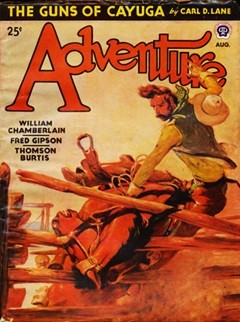
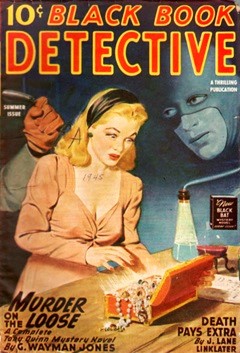
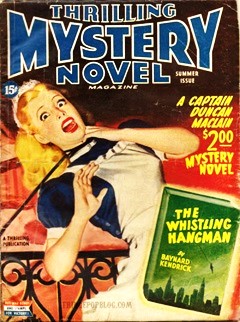
To view the entire list of Old Time Radio episodes go here.